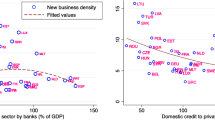Abstract
Theory suggests that capital is more likelyto be efficiently allocated via marketmechanisms, such as bank lending and stockissuance, than via non-market allocation. Consequently, we conjecture that increasedmarket allocation of capital will enhanceeconomic growth. We also posit that goodcollateral and corporate law will increasethe allocation of capital via debt andequity markets, respectively. Usingmeasures of statutory law as instrumentsfor market-mobilized capital, to controlfor its endogeneity in a cross-countrygrowth regression, we demonstrate a clearcausal link between financial marketdevelopment and economic performance.
Similar content being viewed by others
References
Azfar, O. (2001). The logic of collective action. Elgar companion to public choice. Cheltenham: Edward Elgar.
Bagehot. W. (1873). Lombard Street: A description of the money market. London: Henry, S. King & Co.
Davidson, R. and MacKinnon, J. (1993). Estimation and inference in econometrics. Oxford: Oxford University Press.
Goldsmith, R. (1969). Financial structure and development. New Haven: Yale University Press.
Hart, O. (1995). Firms, contracts and financial structure. Oxford: Oxford University Press.
Hicks, J. (1969). A theory of economic history. Oxford: Oxford University Press.
King, R. and Levine, R. (1993) Finance and growth, Schumpeter might be right. Quarterly Journal of Economics 108: 717–737.
Knack, S. and Keefer, P. (1995) Institutions and economic performance: Cross-country tests using alternative institutional measures. Economics and Politics 7: 207–228.
La Porta, R., Lopez-de-Silanez, F., Shleifer A. and Vishny, R. (1997). Legal determinants of external finance. Journal of Finance 52: 1131–1150.
La Porta, R., Lopez-de-Silanez, F., Shleifer A. and Vishny, R. (1998). Law and finance. Journal of Political Economy 106: 1113–1155.
Lanyi, A. and Lee, Y. (2003). Governance aspects of the East Asian financial crisis. In O. Azfar and C. Cadwell (Eds.), Market-augmenting government: The institutional foundations for prosperity. Ann Arbor: University of Michigan Press. Forthcoming.
Levine, R. (1997). Financial development and economic growth: Views and an agenda. Journal of Economic Literature 35: 688–726.
Levine, R. (1998). The legal environment, banks and long-run economic growth. Journal of Money, Credit and Banking 30: 596–613.
Levine, R. (2003). Napoleon, Bourses and growth:With a focus on Latin America. In O. Azfar and C. Cadwell (Eds.), Market-augmenting government: The institutional foundations for prosperity. Ann Arbor: University of Michigan Press. Forthcoming.
Levine, R. and Zervos, S. (1998). Stock markets, banks and economic growth. American Economic Review 88: 537–558.
Mauro, P. (1995). Corruption and growth. Quarterly Journal of Economics 110: 681–712.
Modigliani, F. and Miller, M. (1958) The cost of capital, corporation finance and the theory of investment. American Economics Review 48: 261–297.
Olson, M. (1996). Big bills left on the sidewalk: Why some nations are rich and others poor. Journal of Economic Perspectives 10: 3–24.
Olson, M. (1997). Why some nations are rich and others poor: Sturc lecture. The Johns Hopkins University School of Advanced International Studies, Washington, DC. Transcribed at The IRIS Center of the University of Maryland, College Park.
Summers, R. (2003). Some ways good law, good legal institutions, and sound principles of the rule of law can augment markets. In O. Azfar and C. Cadwell (Eds.), Market-augmenting government: The institutional foundations for prosperity. Ann Arbor: University of Michigan Press. Forthcoming.
Treisman, D. (2000). The causes of corruption: A cross-national study. Journal of Public Economics 76: 399–457.
Author information
Authors and Affiliations
Rights and permissions
About this article
Cite this article
Azfar, O., Matheson, T. Market-Mobilized Capital. Public Choice 117, 357–372 (2003). https://doi.org/10.1023/B:PUCH.0000003738.10135.ae
Issue Date:
DOI: https://doi.org/10.1023/B:PUCH.0000003738.10135.ae




